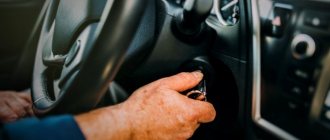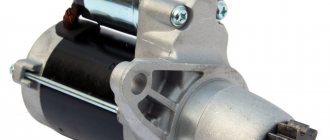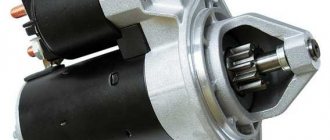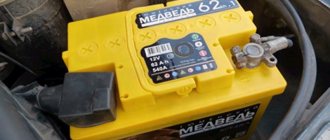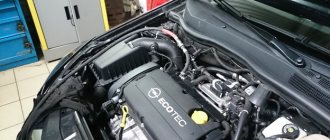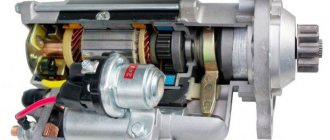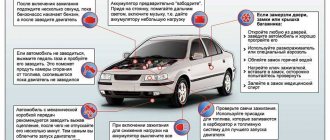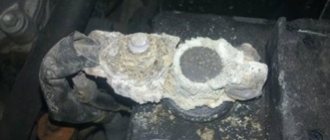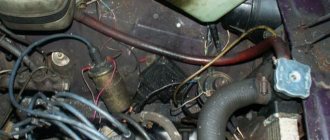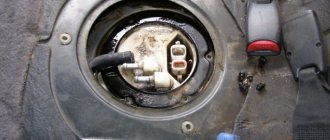The starter is one of the main links in the ignition system. The correct operation of this unit is responsible for starting the internal combustion engine. Reasons why the mechanism may fail: problems with the solenoid relay, discharged battery, opening of the ground contacts, ignition malfunction, violation of the integrity of the electrical wiring, etc. We will discuss the development mechanism, fault diagnosis and methods for eliminating them in more detail in the article.
Troubleshooting
You can often hear the phrase from car enthusiasts: “I get into the car, turn the key in the ignition, and nothing happens.” This occurs due to a breakdown of the starter unit or its electronics if:
- under the hood there are extraneous sounds (clicks, ringing, buzzing), but nothing happens;
- The engine will not start;
- The starter spins when starting, but the engine does not start;
- the crankshaft rotates slowly and the engine is silent;
- You can hear knocking noises under the hood, crackling gears and grinding noises.
Brush unit
If interruptions in the starter operation are observed even at idle, then there is a high risk of problems in the brush assembly. The presence of unstable electrical contact leads to slow rotation of the armature, as a result of which the motor does not catch and does not enter the independent operation mode.
Unreliable contact often occurs due to brushes getting stuck in the guides. Therefore, first of all, it is important to check their free movement.
A large current flows through the brushes. It causes thermal damage such as melting. Therefore, it is important to inspect all elements for defects.
Particular attention should be paid to surfaces in contact with the collector. They are most often damaged. Minor defects require sanding. If it is impossible to eliminate the damage, the brush must be replaced.
Brushes are the most susceptible to wear. You can determine the remaining life by measuring their length. Further decisions should be made by referring to the table below.
Table - Brush wear
| Wear level | Action |
| Complete erasing down to the wires | Mandatory replacement. Even test starts of the starter are prohibited during repairs. There is a risk of damaging the anchor. |
| Less than 30% of original size left | Mandatory replacement before assembly |
| There is half a brush | The need for replacement should be determined by the condition of the remaining elements |
| More than 70% of original size left | It is recommended to reuse the brush |
The most common causes of breakdowns
These are faults in the electrical circuit. These include:
- battery charge less than 12 V;
- oxidation of contacts;
- lack of current on the solenoid relay;
- breakage of the solenoid relay;
- wear of the brush assembly;
- armature commutator wear.
In the case when the retractor does not work and the starter is silent when the key is turned, the breakdown may be the result of a short circuit or open circuit to ground of the traction relay, or short circuit of the turn.
The culprit is electronics even if, when the ignition is activated and the engine starts, the flywheel disk rotates too slowly.
The mechanical causes of malfunctions can be judged by the lack of rotation of the crankshaft when the starter is working. When turning the key, the engine may not operate in the following cases:
- the slip clutch is broken;
- the release lever is faulty or disconnected from the axle;
- the buffer spring is worn out;
- Drive ring is broken or worn.
Unreliable connection between the traction relay and the electric motor
If, after turning the ignition key, the solenoid relay clicks, but the electric motor does not hum, then the culprit is often the conductor connecting them to each other. Under the influence of an aggressive environment and passing large currents, the wire gradually deteriorates. To eliminate the break, it is recommended to weld or solder a new copper conductor.
Lack of contact in the starter circuit
Occurs as a result of metal corrosion or loosening of bolted wires. In addition, you need to check the grounding of the retractor and main relay of the starter assembly. You can check your car's electronics using a multimeter. Before doing this, inspect the wiring, tighten the bolts and check the terminals. If there is contact loss, restore their integrity.
Summarizing
It is advisable that the starter spins the engine crankshaft during an attempt to start it for no more than 10 seconds, then the device must be given a minute pause. Failure to comply with this rule will, at best, lead to a discharge of the power source, and at worst, it will completely disable the starter. Only replacing it can save the situation, since not every auto electrician will undertake the task of rewinding burnt windings, since it is not always possible to perform this procedure efficiently. In addition, the cost of this service is comparable to the cost of a new element.
Why does the engine rotate inefficiently?
There are times when the starter works, but does not turn the engine with the required force. Let's list the situations when this happens:
- When using oil that does not correspond to the temperature conditions. The lubricant thickens and prevents the crankshaft from rotating. It is necessary to replace the lubricant with one regulated for the given weather conditions.
- Low battery charge. Does not provide energy for effective rotation. The battery needs to be recharged or replaced.
- In case of a malfunction of the brush assembly. It is necessary to check the contacts of the brushes and the tightening force of the tips going to the part.
Planetary gear
If the starter shaft is difficult to rotate, a common cause is thickening of the lubricant in the planetary gear. At the same time, when the engine is cold, the electric motor turns the crankshaft worse than when the engine is hot. This is due to the fact that the lubricant changes its viscosity depending on the temperature. When hot, it liquefies and interferes less with the rotation of the shaft.
To solve the problem, you need to disassemble the planetary gearbox and clean out all the contents. After this, new lubricant should be applied.
The reasons why the starter does not work well and turns weakly are often related to the condition of the planetary gearbox gears. Therefore, it is important to inspect them for signs of wear and broken teeth.
The mechanism does not function on a hot engine
The answer to the question of why the starter does not turn when hot lies on the surface. The bushings expand during engine operation, the unit begins to “wedge”, or it fails. As a rule, this problem occurs in cars with high mileage. Let's look at why this happens in the table.
| Cause of malfunction | Solution |
| Wear of standard bushings | Replacement |
| Bad contacts | Clean, tighten, treat contacts |
| Reducing the insulation resistance of the stator winding | Replace winding |
| Oxidized contact plates in the relay | Clean or replace |
| Foreign particles in the starter housing | Clean up |
| Brush assembly wear | Cleaning the brushes or replacing the unit |
Stator problems
Staters of modern starters are mainly made using permanent magnets, but there are also units with classical windings. Insulation breakdowns, breaks and interturn short circuits are possible in it. To check the absence of the listed problems, it is recommended to use the diagrams presented in the image below.
The permanent magnet stator has virtually no problems. Despite this, in domestic units, poles may peel off or cracks may appear.
The part does not work either cold or hot
The reasons why the starter does not turn, does not start the vehicle and does not click may be:
- detachment of magnets;
- violation of the integrity of the contact group fuses;
- break in the control wire supplied to the starter. Carry out an emergency engine start. If it helps, the reason is in the ignition, if not, it’s in the wire;
- return spring failure.
Information about the design of the starter and its supply wiring
An automobile starter is attached to the engine block and is designed to impart rotation to the crankshaft through a ring gear on the circumference of the flywheel. The main components of the starter:
- An electric motor consisting of a rotor, a stator and a brush unit that powers the rotor windings.
- Freewheel with drive gear (Bendix). This also includes the simplest mechanism that moves the coupling along the shaft.
- Solenoid relay. A powerful solenoid that controls the supply of the clutch and also closes the power contacts of the electric motor.
Two electrical circuits are connected to the starter, a power supply and a control or signal circuit. The first supplies all the energy consumed during operation, and the second serves to turn the device on and off.
Starter operation in normal mode
When the driver gives a command to start the engine, the ignition switch contacts that switch the starter are closed, and voltage is supplied to the control relay. It is used to unload the contact group of the lock from high currents of the pull-in winding. Sometimes this relay is missing, then the ignition switch is made more massive, capable of switching without being burned by significant currents.
After the relay or ignition switch, if it is absent, the signal comes to the control contact of the solenoid relay. Both of its windings are triggered, after which the retractor is excluded from the circuit, and the retainer continues to supply power through the power contacts to the electric motor. At the same time, due to the movement of the solenoid armature, the freewheel engages with the flywheel, imparting rotation to it from the starter. When the engine starts, it throws the clutch back, thereby preventing the starter from “racing” at high uncontrolled speeds. The driver turns off the starter, removing the voltage from the holding winding, the spring returns the solenoid armature to the forward non-working position. Sometimes this is done automatically by control electronics.
The mechanism makes clicks but does not rotate
When the starter clicks once, but does not start the engine, this means that the unit requires repair. You need to try to start the car again. If it doesn't work, then it's probably the following:
- Bendix is broken;
- the starter winding is broken;
- a short circuit has occurred;
- the solenoid relay is faulty;
- brushes are worn out.
In this case, you need to replace the parts.
Security system activated
Modern cars are equipped with an immobilizer. This means that in order to start the engine, the on-board computer requires a response from a transponder or chip in the key containing a specific code.
There are millions of variations of codes, and if the key is damaged or contains an incorrect code, the security system will prevent the ignition from turning on or block the engine.
Usually such problems are indicated by a message on the dashboard. If the sensor detects an incorrect code in the key, the car, as a rule, reports its reaction to this with additional signals from the headlights or turn signals. There are two possible breakdowns in this case:
You may also be interested: How to choose reliable mud flaps for your car
- The car did not recognize the key.
- The security system is faulty.
Issues such as a broken immobilizer antenna or broken wiring surrounding the lock cylinder may prevent the code from being read. There can be many reasons why the on-board computer does not recognize the chip. The simplest one lies in the fact that some keys operate only on battery power, without which the chip is not recognized by the on-board computer.
In this case, the repair consists of replacing the galvanic element. For more complex malfunctions of the immobilizer system, you should contact a service station or key reprogramming specialists.
What to buy?
- 2110-3708010, -03, 04 – 9 teeth, 2 holes;
On the right is the BOSCH starter, on the left is PROMO-ISKRA
The choice depends on the type of gearbox. And nothing else.
Chemistry
There is no need to clean copper with WD-40 - after that everything will only get worse. Special equipment needed:
- Ammonia;
- ASIDOL (Lenbytkhim LLC) - excellent, by the way, also polishes glass;
- Molykote S-1002;
- Kontakt 60 or 100 (acid) and WL (wash);
- CRAMOLIN ContaClean (acid).
CRAMOLIN requires a remover. It's easier to take an eraser and ammonia.
Safety block, wires, terminal blocks
The so-called black box of the motorist, in which fuses and relays are located, quite rightly comes into question in such situations. A short circuit or simply stagnation of contacts may occur in the block. Experienced motorists recommend not hitting the block too hard, this really helps.
If that doesn’t help, find the terminal blocks with the power wires and clean them thoroughly from oxides. Then carefully solder everything.
You can also test the ignition switch and clean the chips whose wires go to the starter. It is better to replace the nuts on the terminals with brass ones to make contact better.
